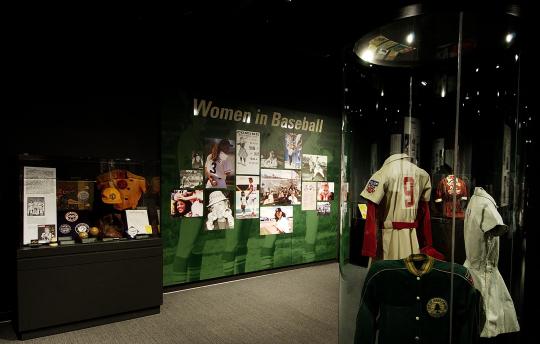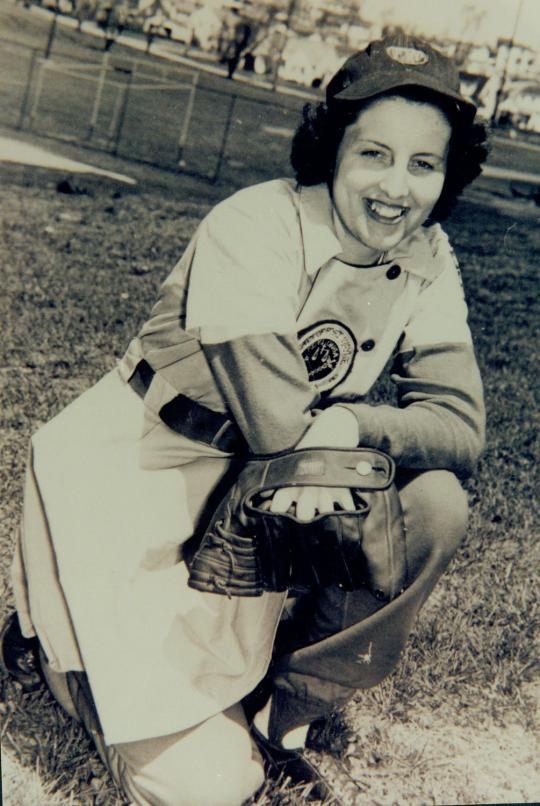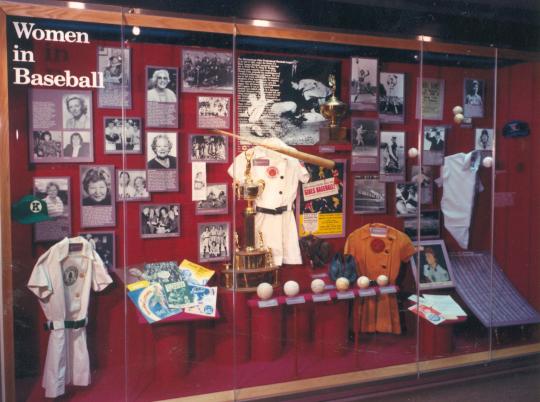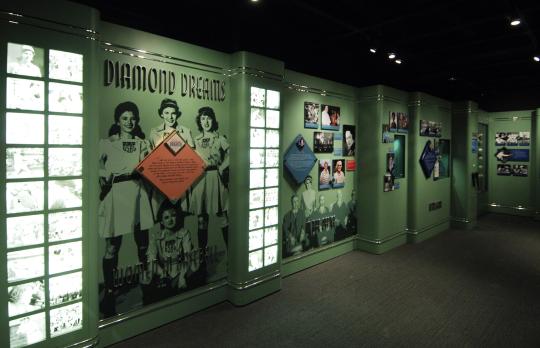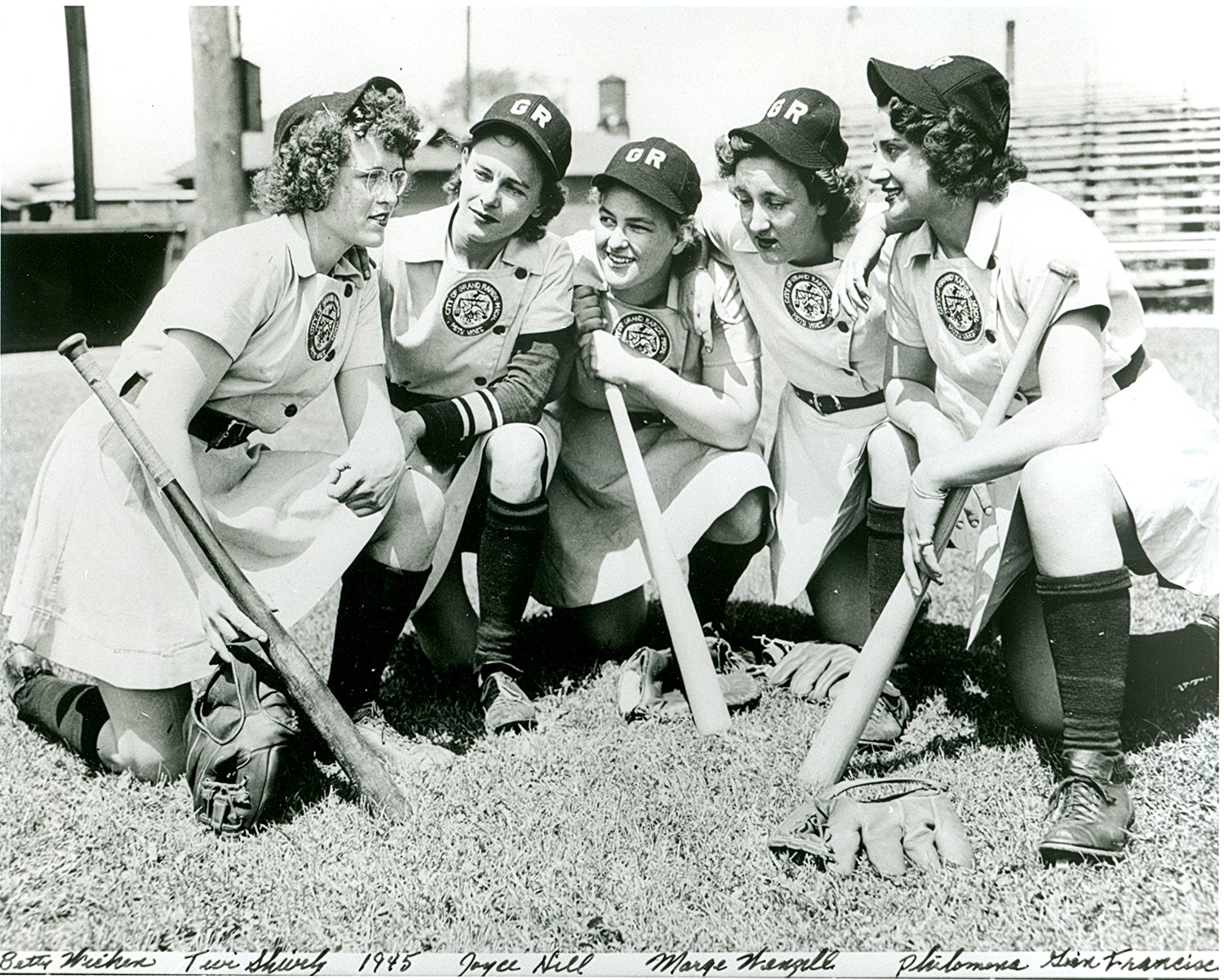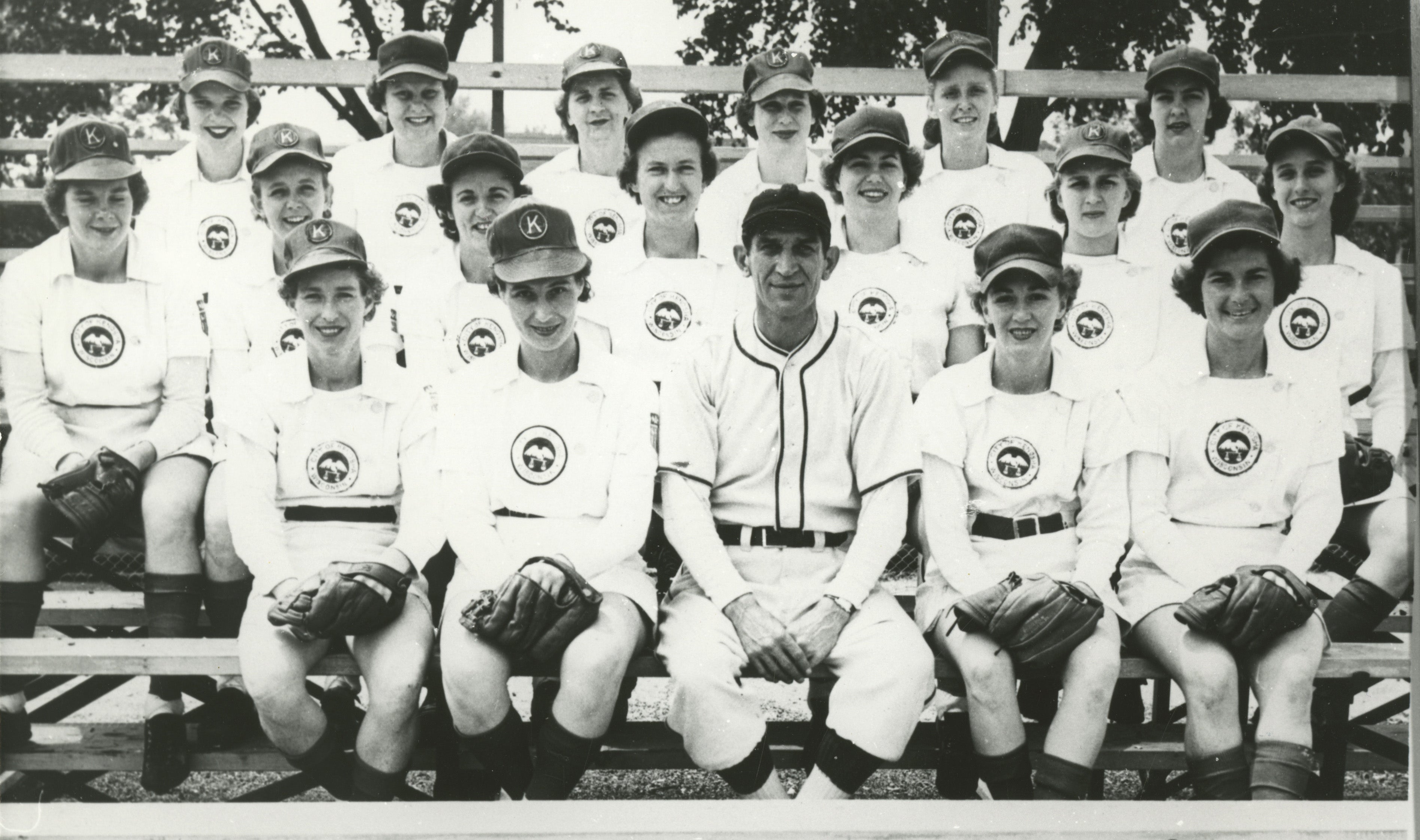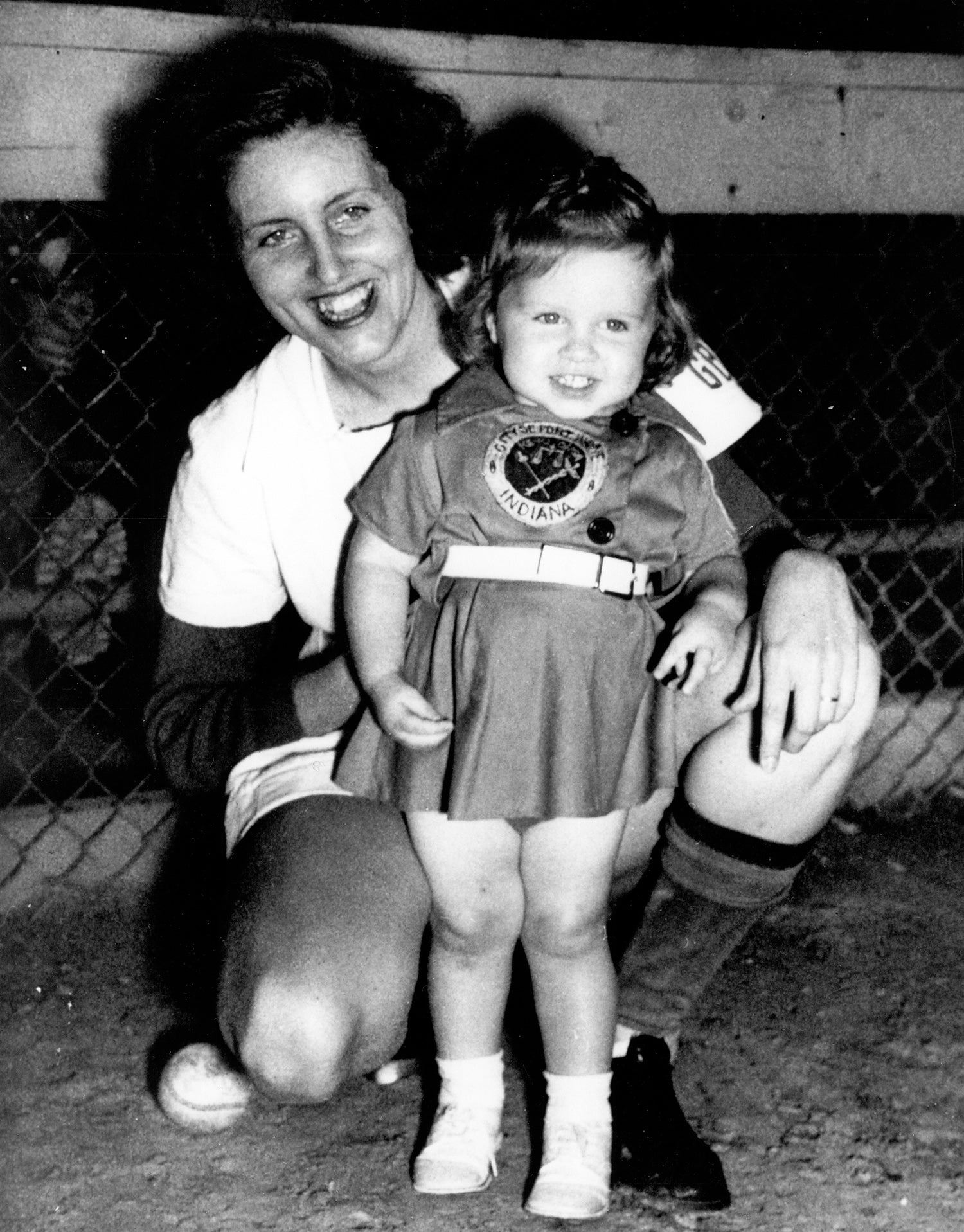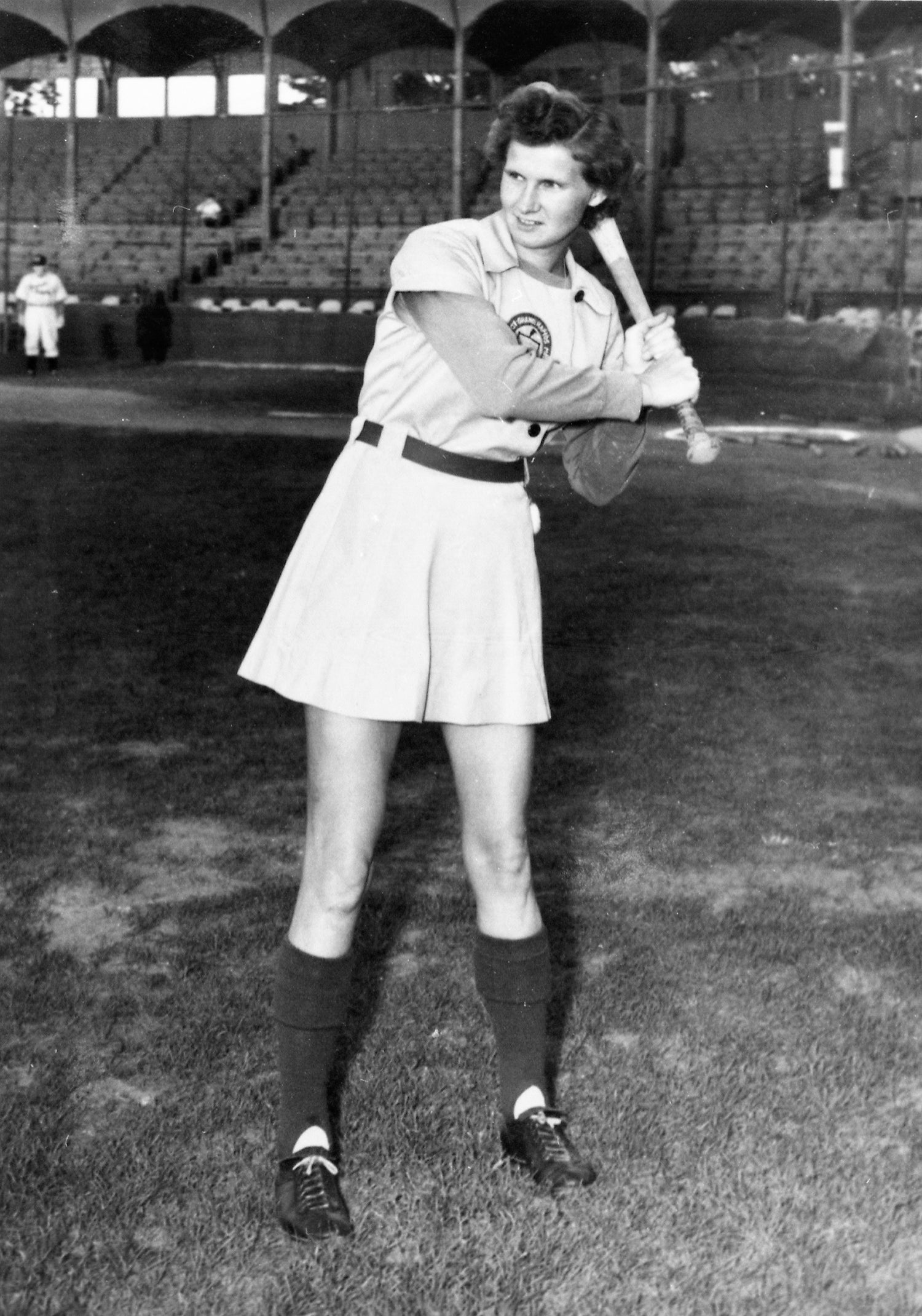- Home
- Our Stories
- 30 years ago, the AAGPBL came to Cooperstown
30 years ago, the AAGPBL came to Cooperstown
The space measured roughly eight feet by eight feet.
Yet the memories, artifacts, stories and recollections alone on Nov. 5, 1988, could have filled an institution at least twice the size of the National Baseball Hall of Fame and Museum.
Hall of Fame Membership
There is no simpler, and more essential, way to demonstrate your support than to sign on as a Museum Member.
The women of the All-American Girls Professional Baseball League (AAGPBL) – always proud of their on-field exploits and off-field impact – had finally returned to the public conscience over three decades after the league shut down, appearing in a 1987 documentary shown on public television, as well as in many newspaper articles. The recognition they sought, however, was from Cooperstown – a permanent exhibit to tell the current and future generations about the professional baseball league for women which lasted between 1943 and 1954.
They got it.
About 150 of the over 500 women known at the time to have appeared in the AAGPBL – along with about 300 friends and family members – descended upon Cooperstown for the grand opening of the “Women in Baseball” exhibit, the culmination of a few years’ work by Hall of Fame curator Ted Spencer, just ahead of the museum’s 50th anniversary in 1989. As it happened, while growing up in Quincy, Mass., one of Spencer’s physical education teachers, Mary Pratt, was a former AAGPBL ballplayer.
Situated on the second floor, at the top of the stairwell, the new exhibit took the spot once held by the “Evolution of Equipment” displays, with the old exhibit heading to new space created by the merger of the Alfred Corning Clark Gymnasium structure next door into the Baseball Hall of Fame.
The AAGPBL alumnae had begun holding reunions in the 1980s, allowing the far flung vets the opportunity to re-connect and share memories of yesteryear, and sometimes even facing each other in pickup ballgames. At the 1982 reunion in Chicago, the notions of establishing an archive of league history or being recognized by the Hall of Fame were planted in their minds.
By September 1986, a committee was formed at their reunion in Fort Wayne, Ind., where they tried to determine how to achieve a spot in the Baseball Hall of Fame. Dottie (Wiltse) Collins, one of the top hurlers in six seasons spent mostly with the Fort Wayne Daisies, was on the committee and was an integral part of the alumnae group in general. Prior to the reunion, USA Today reported that “former players would like to see their league remembered, perhaps in a permanent collection of memorabilia at the Baseball Hall of Fame in Cooperstown, N.Y.”
With that, the call went out. In an AAGPBL alumnae newsletter, Collins requested the following from membership:
What we need from you now is the following:
Suggestions, names of people that might be able to help. And most important what you would be willing to give to the Baseball Hall of Fame, if we are able to achieve our goal.
We need to have a list to show them. None of the memorabilia will be collected until we have a signed an agreement (sic) with the Baseball Hall of Fame that it will be a permanent display.
For the Hall of Fame’s part, the challenge was not so much its interest in highlighting women’s roles in baseball history. Rather, it was coming up with the tools to tell the story, according to Spencer’s comments in a January 1987 Los Angeles Times column.
“Asked if the Hall of Fame had plans for an exhibit…Spencer said, ‘The answer is absolutely. We’re not just showing the major leagues. We should be showing baseball. There’s no opposition within the staff here. … It’s going to happen,’” the column noted, with Spencer emphasizing two potential issues: “I don’t have the space and I don’t have the materials. Right now all I’ve got is a set of … baseball cards.
“If someone would deluge us with old uniforms, it’d be spectacular.”
Spencer had acquired the cards in a 1984 meeting with Sharon Roepke, who also provided him with a pamphlet on the league and its history.
Sure enough, after Collins’ and Spencer’s requests, the deluge came.
Offers of uniforms, photographs, balls, scrapbooks, equipment, printed materials and other ephemera related to the AAGPBL began to pour in.
Spencer reached out to Collins by phone in January 1987 informing her of the decision to go ahead with the exhibit, initially slated to open in 1989, which would measure about 64 square feet.
“Some people will think that because we aren’t men, and never played against men, that we don’t belong (in the Baseball Hall of Fame),” 10-year AAGPBL vet Lavonne “Pepper” Paire Davis said in 1987. “But none of us ever wanted to compete against men. That wasn’t the point; it’s so hard to explain. We deserve this; baseball was our lives.”
As the months wore on, Spencer and the AAGPBL alumnae – which turned into the AAGPBL Players Association – collaborated on the exhibit, seeking out film clips and other items to add. Additionally, in an effort to draw more participants, the Association decided to hold its annual meeting in Cooperstown when it became clear that the exhibit would go up in the fall of 1988.
In addition to covering the women of the AAGPBL, Women in Baseball also would feature information on female baseball executives and women making inroads as umpires, according to Spencer.
At 1 p.m. on Nov. 5, before hundreds of AAPGBL alumnae and guests, Women in Baseball opened to the public as Collins and Museum director Howard Talbot pulled the drapes.
“We don’t ordinarily unveil new exhibits when they open,” Spencer said at the time. “But when the women suggested that we do with this one, we said, ‘Why not?’”
Reaction was largely positive. For many, like Mary Pratt, it was a “dream come true” and “a wonderful role model for the youngsters coming along.”
“It was beautiful. We had so many people,” Sarah “Salty” Sands Ferguson recalled in 2018, “they told us that we had a bigger crowd” than was at Willie Stargell’s induction earlier that year.
Katie Horstman, who grew up on an Ohio farm and joined the AAGPBL as a high schooler, remembered that she “thought the exhibit was super.”
“Oh, we never thought that,” Horstman said when asked about ever thinking the AAGPBL would receive recognition one day by the Baseball Hall of Fame. “When we heard that, it was out of this world.”
“That had to be the biggest event of my baseball life next to my first spring training in 1949,” Shirley Burkovich recollected. “We were very pleased with the exhibit, the way it was set up and all.
“When we were playing ball, we were just so happy to have that opportunity that I don’t think anything else ever entered our mind. We didn’t know we were pioneers. We were just doing something we loved, and that was playing baseball. We realize now that we were doing something special, and it’s very gratifying.”
Not only did players and their guests attend, but Ken Sells, the league’s first president, was also in Cooperstown that Saturday.
Merrie Fidler, an AAGPBL researcher, was there to donate a copy of her thesis, which became the basis of her 2006 book, "The Origins and History of the All-American Girls Professional Baseball League". She also offered a slideshow of the league and its history.
According to Gloria Cordes Elliott, who played five seasons in the league, “I’m sure our being honored will be inspirational to young women. A lot of them do look up to me when they hear I played ball.”
June Peppas, president of the Players Association, in the group’s newsletter later thanked Spencer and Talbot for all their work in making the exhibit possible, and highlighted Collins’ efforts in coordinating everything going into the exhibit.
Spencer recalled to Carolyn Trombe in 2004 the joyous nature of the AAGPBL alumni on that day:
[We] looked out and there [were] 1,200 people. Here’s a day where we have 400 people. That’s what we’d have on a Saturday in November, 400 people. The placed was [packed], and they sang that [AAGBBL] all day long. … And this museum [had] never had that much noise! It was great. …To me it changed the whole direction of the museum because it brought home how important the game is culturally.
Collins expressed the sheer delight of being included in baseball’s shrine.
“We are thrilled to be accorded a place of honor in the history of our national pastime,” she said. “At the time we were just kids having fun. Not until it was all over did we realize that we had been pioneers as far as women’s sports are concerned. This is the thrill of a lifetime for us.”
The opening of Women in Baseball would be loosely re-enacted on the silver screen four years later when director Penny Marshall’s A League of Their Own debuted in movie theaters in 1992. The film, though fiction, drew heavily on the history of the league and its players and personnel, and it gave national exposure to the league as well as the exhibit in Cooperstown, allowing many to visit and learn about the roles women have played in baseball since the game’s earliest days.
Over the past 30 years, the exhibit, re-curated and renamed Diamond Dreams in 2006, continues to inspire males and females alike with the stories of those girls and women who still break through baseball’s glass ceilings at numerous levels: From Maria Pepe’s lawsuit to just be able to play Little League baseball through Mo’ne Davis’ standout performances at the 2014 Little League World Series; from the Bloomer Girls of yesteryear to the AAGPBL and, later, the Colorado Silver Bullets; from Ila Borders pitching in a North American men’s professional league to Eri Yoshida doing the same on both sides of the Pacific Ocean.
Diamond Dreams expanded on the foundation laid by Women in Baseball in 1988 and will be a focal point of the museum well into the future, as women surpass long-standing barriers, take on new challenges and continue to achieve greatness in baseball.
“We did pave the way (for future generations)", said Horstman, who threw out a ceremonial first pitch at Yankee Stadium in 2018 to recognize the 75th anniversary of the AAGPBL.
Horstman noted, however, that it was not until A League of Their Own hit theaters that people began to believe that she and her peers did, in fact, play pro baseball. Burkovich agreed with that assessment, as the film reached a national audience. The film helped make the exhibit, she thought.
“When the movie came out, gosh, you knew everything,” Burkovich said. “Marshall did an excellent job portraying the league. People didn’t know there was a baseball league unless you lived in the Midwest at the time.”
“I think [the exhibit] made a big difference. That’s what we had in mind when we had our first reunion,” said Ferguson, who regularly speaks about her baseball career to schoolchildren. “We said we don’t want to be inducted either as a league or as individual players. We just wanted a display so people knew what we did so many years ago.”
Ferguson added that she encourages anyone who is passionate about something to go out and pursue it, much as she took on pro baseball.
“Don’t let anybody tell you that you can’t fulfill that dream,” she said.
For the AAGPBL alumnae, the dream of permanent recognition by the baseball establishment was fulfilled on that November day in Cooperstown.
As Peppas wrote in the AAGPBL Players Association’s December 1988 newsletter:
If we never do anymore we have gotten our display there for all America to see. Every man, woman, boy and especially the girls that travel through their hallowed halls will now see the All American Girls Professional Baseball League. They will see action shots, individuals, lots of league memorabilia and above all they will see the names, hometowns, and years played by our players. For this we should all be very, very proud.
Thirty years later, the pride remains, as strong as ever.
Matt Rothenberg is the manager of the Giamatti Research Center at the National Baseball Hall of Fame and Museum

